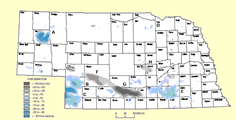Natural Resources, School of

Conservation and Survey Division: Faculty and Staff Publications
Document Type
Article
Date of this Version
2-19-2024
Citation
Near Surface Geophysics 2024;22:402–417. DOI: 10.1002/nsg.12295
Abstract
Shallow, dominantly silt- and clay-filled erosional troughs in Quaternary sediments under the Flathead Valley (northwestern Montana, USA) are very likely to be hydraulic barriers limiting the horizontal flow of groundwater. Accurately mapping them is important because of increasing demand for groundwater.We used a legacy Bouguer gravity map measured in 1968. The directional derivatives of the map are computed, and the map was enhanced by implementing edge detection tools.We produced generalized derivative, maximum horizontal gradient, total gradient and tilt gradient maps through two-dimensional Fourier transform analysis. These maps were remarkably successful in locating buried troughs in the northern and northwestern parts of the study area, closely matching locations determined previously from compiled borehole data. Our results also identify hitherto unknown extensions of troughs and indicate that some of the buried troughs may be connected.
Included in
Geology Commons, Geomorphology Commons, Hydrology Commons, Paleontology Commons, Sedimentology Commons, Soil Science Commons, Stratigraphy Commons


Comments
Open access.